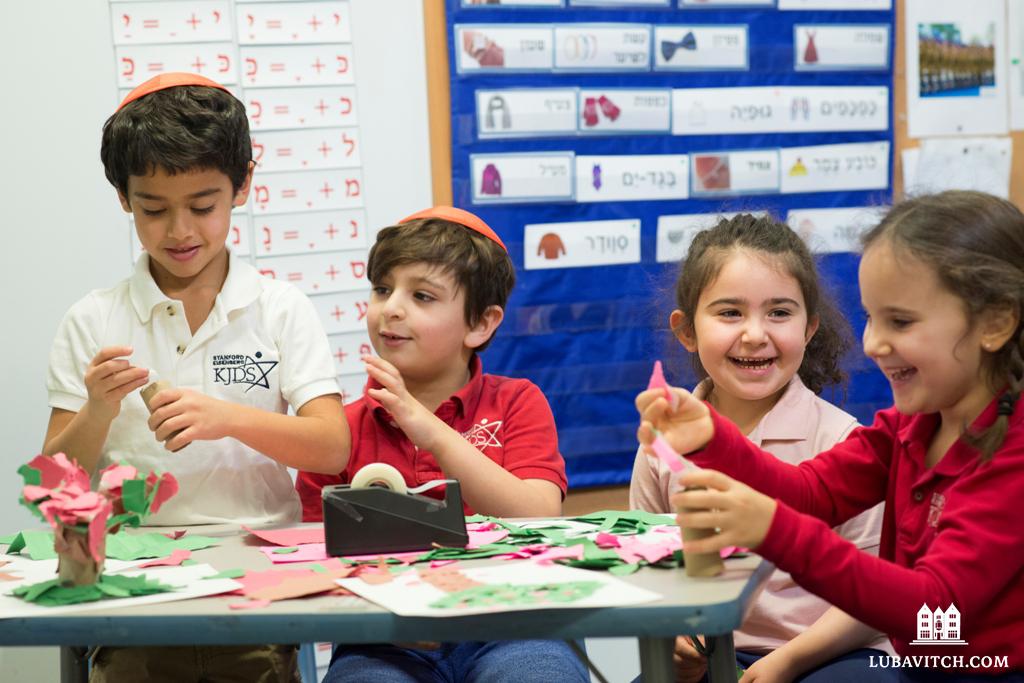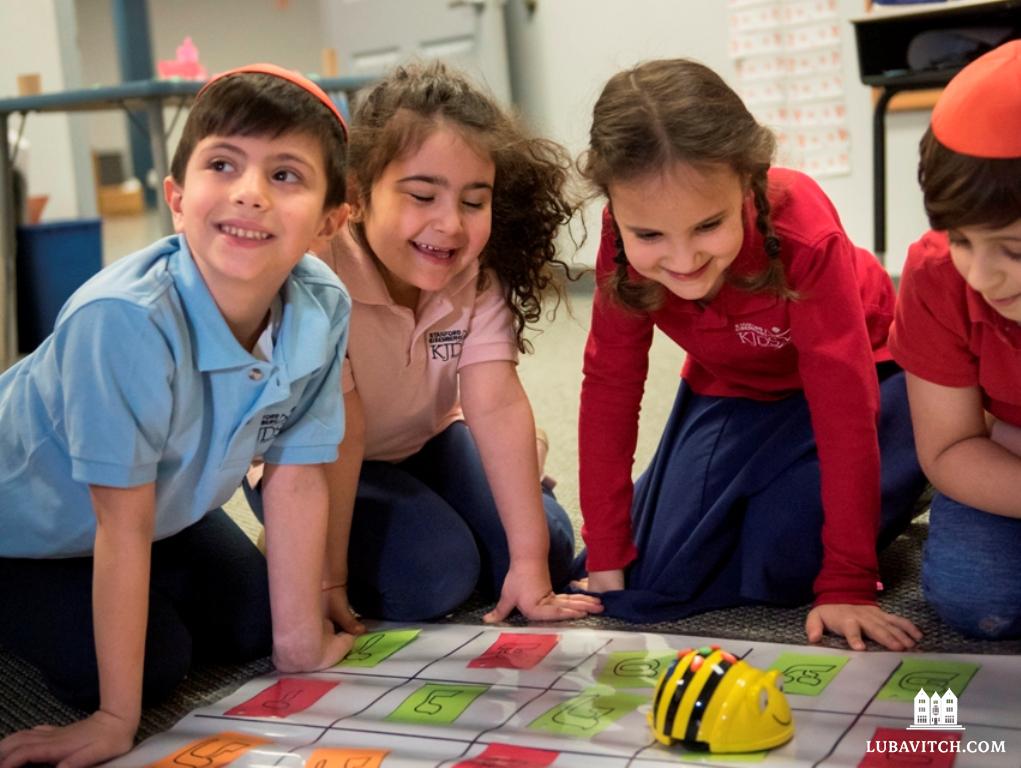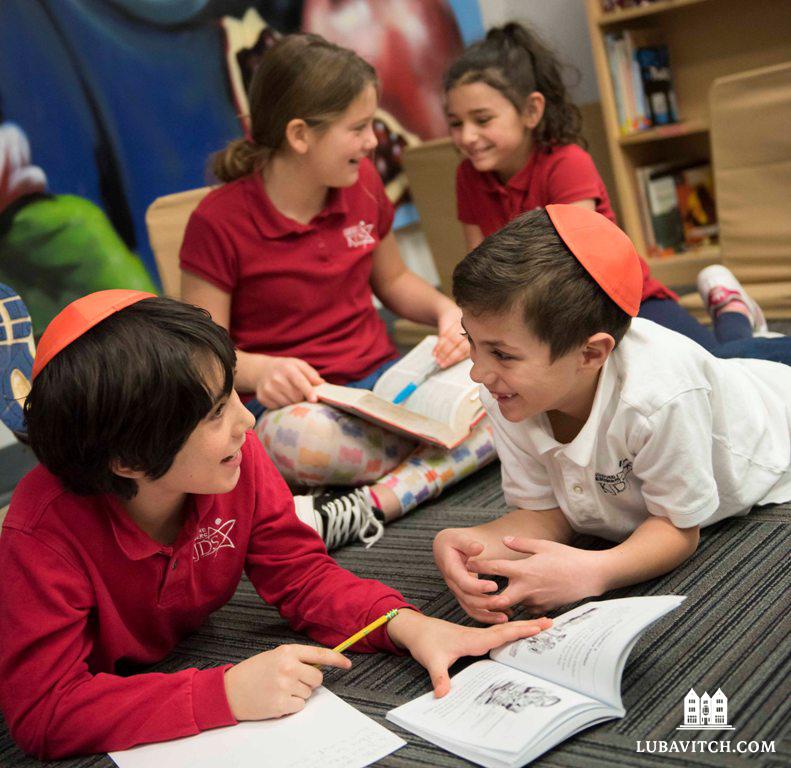Rabbi Yossi and Miriam Esther Wilhelm waited in suspense. Stanford Eisenberg Knoxville Jewish Day School (KJDS) had just ended its first year of operations with eight students. Facing expensive educational investments—a music curriculum, a full stock of art supplies, a week of teacher training—the Wilhelms struggled to cover costs. Partners for Excellence in Jewish Education (PEJE, now PRIZMAH) was offering a $100,000 grant to nascent institutions, representing a windfall for this tiny school. The forms had been eagerly filled out; the interviews completed. An inspector flew out to visit.
A few weeks later, the email came: “We regret to inform you, but . . . ” The money went to a school in Asheville, North Carolina, instead.
“They thought we were too much of a ‘one-room schoolhouse,’” Miriam Esther says. “The other school had spent a lot more time on market research and data analysis. They didn’t think we’d make it for the long-term.”
The Wilhelms soldiered on, pulling funds together from “lots of different places” and improvising as needed. A year later, Asheville’s school shut down. This fall, the Stanford Eisenberg Knoxville Jewish Day School kicked off its twelfth year with thirty students.
Since their first application, the Wilhelms have gotten used to rejection letters. Most grants require a minimum of fifty students for eligibility. KJDS’s maximum capacity is forty-five—about half the Jewish kids in the neighborhood. “I try to explain our unique situation to the foundations,” says Wilhelm, who leads fundraising efforts for the school, “but they don’t get it.”
Small Jewish day schools—those with less than 100 students—occupy a fragile place in our society. Located outside of centralized Jewish communities, these schools must fight for recognition, not only from foundations, but also Jewish Federations, potential donors, and prospective parents. With no endowment funds, they still accept every Jewish student regardless of financial ability. Working on shoestring budgets, they must compensate with creativity to develop cutting-edge curriculum on par with local private schools. Welcome to the new frontier of Jewish education.
THERE ARE ROUGHLY 35,000 private schools in the U.S. Close to 1,000 are Jewish day schools. About a tenth of those are community schools enrolling 14,849 students. To put that in perspective: last fall, over 50 million students enrolled in some 100,000 public elementary schools across the nation. In the niche spot within a minority of a minority of these numbers, lies a relatively new phenomenon: the small community Jewish day school.
One state over from Knoxville, in a Jewish community three times its size, ninety-three students attend Charlotte Jewish Day School. One of them is Leah, a second-grader who approaches her Jewish studies teacher shortly after spring break. “I ate bread on Passover,” she confesses, bracing for inevitable disappointment.
“Okay, Leah,” the teacher smiles. “Did you eat matzah?”
Like Knoxville’s, Charlotte’s principal is a Chabad emissary, but the school itself is not affiliated with the Chabad. Mariashi Groner, head of school, has collaborated with her board of directors to develop a Jewish curriculum that works for the whole spectrum.
“We want to make sure everyone feels safe,” she says. Students from interfaith homes might be learning about Shabbat alongside Orthodox ones, so the classroom narrative focuses “on what we have in common.” On a playing field where, as a recent JData report put it, “turfism is more common than collaboration,” the unity in North Carolina is noteworthy.
The school board of KJDS recognizes a similar theme. Says board member Gloria Greenfield, “The challenge is that there are segments of the community fearful of any institution affiliated with Orthodox Judaism.” Another member, Nancy Becker, is quick to point out that “most people would actually be surprised by how egalitarian the school is.”
In Austin, Texas, head of school Rochel Levertov takes a different approach. “Our school is explicitly run by Chabad,” she says. The arrangement allows Rochel to make executive decisions about policy without needing to consult a board. It also means that uninformed parents are sometimes reluctant to sign up. She tells a story of a recently enrolled family: “They visited every other school in the area first.”
The experience is familiar to the principals in Charlotte and Knoxville who have all found that once a family comes through the door, they usually stick around. “It’s getting them here that’s the hard part,” says Rabbi Wilhelm.
SCHOOLS WITH LESS THAN 100 students have a harder time getting established. When it comes to numbers, a measure directly affecting revenues, only 40 percent of small Jewish private schools were able to grow their student bodies. Compare that to 70 percent of larger schools. Empty seats in a classroom are expensive, driving up cost per student. Miriam Esther recalls the loss to KJDS of three students when one family moved away. “That hit us hard,” she admits.
Shani Bechhofer is a consultant who helps Jewish schools streamline their administrative processes. “Institutions benefit from economies of scale,” she explains. Overhead and administrative costs of running a school for thirty children in Knoxville might be similar to those of running one for 300 in Chicago. On average, though, schools with under 100 students are only filling 60 percent of their seats, one indicator of the fragility of the two-digit school.

For small schools without funding, tuition makes up a large portion of the budget. But many parents don’t want or cannot afford to pay. And in Knoxville, there is a very small pool of Jewish children to begin with. Even once prospective students are identified, KJDS competes against 44 private schools in the area, most of them with lower tuition. (The average cost of a Knoxville private school is $7,872, compared to the KJDS tuition of $10,090.)
Even in places where many have a strong cultural affinity for Judaism, selling parents on the idea of a Jewish education takes effort. “The concept of a day school isn’t in the lexicon in Charlotte,” says Groner. “There’s no frame of reference.” So what gets parents on board to spend more than $10,000 a year on a child’s education? A majority of parents who choose CJDS do so “despite the Judaism” observes Groner. They are willing to make the investment for its high academic standards.
A FEW HOURS EAST of Los Angeles, ten students in a combined kindergarten-first grade class are learning the story of Exodus in Palm Desert’s Aleph Schoolhouse, a fledgling school in its first year of enrollment. The kids model Moses’ baskets from clay while lead teacher Moshe Witkes passes between the groups, stopping to offer advice or answer a question. “Will it float?” A six-year-old asks after the clay figures have been set out to dry.
Moshe pauses and thinks for a moment. “Well, what makes something float?” The group veers off into a conversation about buoyancy and density, ending with a plan to test the baskets in water next lesson. Art, physics, and Jewish studies are wrapped up into one engaging project.
Stroll through the brightly painted halls of Hebrew Preparatory School in Austin and you won’t see kids sitting at desks or raising their hands. Instead you’ll find a roomful of engaged first graders learning through movement using a research-based software called Neuronet. At recess, kids channel their inner architects—building elaborate structures out of foam blocks with an equipment system called Imagination Playground. Learning is experiential. Learning is play.
“Public school here is often all about the tests,” says Nancy Becker. “Here [at KJDS], we focus instead on learning and thinking.” Report cards are replaced by self-assessments. Students gather for “book talks” after completing self-selected readings. In the combined 4th-5th grade classroom, there are no desks—the flexible seating plan looks more like a coffee shop, with community tables and cozy nooks. “Every inch of space is utilized for learning,” says Miriam Esther Wilhelm. Even the hallway doubles as a library and art gallery.
KJDS prioritizes a hands-on experience: touring a construction site, visiting a food lab, or learning how to use 3D printers. One way to emphasize the real-world relevance of the lessons is community service. When students learned architecture, they built a towering structure of 1,000 soup cans, which went to charity once the project finished. “STEAM into service” is the idea animating science, technology, engineering, art, and math lessons. A module on environmental sustainability included working with the staff of Knoxville’s mayor to devise new initiatives for the city. “We’re not teaching lessons, we’re teaching students,” says Wilhelm.
A report by JData, “Mapping Jewish Education,” finds that the rate of experimentation in the field of Jewish education appears to be accelerating, and KJDS makes a perfect case study. In the drama department, where kids practice for their annual play, performed in a professional theater before an audience of hundreds, they learn confidence, poise, and discipline. “The kindergarteners with stage fright turn into fifth graders with lead roles,” says parent Michael Zemel. “This is the out-of-the-box thinking that we love about the school.”
ZEMEL, WHOSE DAUGHTER SARAH is a 5th grader at KJDS, has noticed the school’s success at cultivating something that even fat tuition fees don’t guarantee. “If a child drops their lunchbox, there’ll be three or four children there to help.”
The students’ response is anything but incidental. Schools have traditionally seen themselves as responsible in the realm of academics, and have been slower to adapt to the recognition that all aspects of a child’s training “fall under their domain.” But KJDS is a vanguard for innovation. “We put a lot of creativity and energy into teaching good character traits like kindness and generosity,” says Miriam Esther. The “Kavod [Honor] Code” is a procedure for peer interaction based on mutual respect and acceptance. “We wanted to create an extremely safe environment in which children accept productive struggles and embrace failure.”
Children born to millennial parents made up 82 percent of births in 2015, according to data by the Pew Research Center. Valuing freedom of expression and individuality, and eschewing the overscheduled after-school calendars of their own childhoods, they are challenging schools to think outside the box. “The whole notion that the teacher will discipline the student is outdated,” says Bechofer. Instead, “schools need to teach self-regulation, responsibility, study skills . . . ” Whether that means teaching kids how to organize a backpack or control appetite at snack time, these skills are “crucial to the child’s success as an adult.”

IN KNOXVILLE, POSTAL WORKERS don’t say “have a good day.” Instead, it’s a universal “have a blessed day.” Religious identification in the state is at 86 percent of the population, according to a Pew population study. In the geographical area nicknamed the “Bible Belt,” Tennessee is the “buckle.”
Debbie Abrams Cohen, 45, grew up as one of a handful of Jews in Knoxville’s public and private school system. “Everyone knew I was Jewish, but I still always had friends ask why I didn’t have a holiday tree.” It was not unusual for her to interact with people who had never met a Jew before. “People here have good intentions, but they are clueless.” Jewish kids in the area’s schools can feel marginalized. “Wednesday is church night here,” Abrams Cohen says, “so there aren’t usually scheduled activities—sometimes there isn’t even homework!”
Nancy Becker, Debbie’s mom, tried doing what the Wilhelms set out to accomplish. “When my kids were young we tried getting this project off the ground—twice.” The response was weak; the parent body fragmented; the funding scarce. “It fell apart.”
The Chabad couple succeeded, she says, because they came to it with resolve. “They didn’t get stuck strategizing or deliberating. They just dove right into it.”
One of the first programs Miriam Esther started was a Mommy and Me group. Eight moms joined and formed a core group of friends. She soon noticed that frustration with the struggle of staying Jewish in public school was “the constant conversation.” The city’s 3,000 Jews, three hours away from communities in Atlanta and Nashville, felt they needed to stick together—and get involved.
Although she is the daughter of two principals, and with years of teaching experience and a passion for education, opening a school was not on her mind when Miriam Esther moved to Knoxville. “But we got here, looked around.’” The community supported a Jewish Community Center/Federation alliance, a conservative synagogue, and a reform temple, but there were no Jewish school options.
Confronted with the overhead costs of opening a school, they wavered. Then, as if out of the blue, a woman called to make a donation for the seed capital needed. She wanted the school named after her father. “We figured that G-d must want this.” The Wilhems moved forward even though the financial challenges of operating a Jewish day school in such a small community were almost insurmountable. “We must have been young and naive,” she confesses. “Because now that I look back I don’t know what we were thinking.”
The Stanford Eisenberg Knoxville Jewish Day School opened a combined kindergarten first grade with eight children, and today, Nancy is one of Knoxville’s community members reaping the benefits. Her grandson currently attends first grade and her granddaughter Samantha graduated KJDS last year. On Samantha’s first day in public school, her friends urged her to join them at church services. They don’t know she’s Jewish, and as one of four Jews in a Tennessee middle school of 600, the topic doesn’t usually come up.
“Most of my friends have never spent time with anyone who isn’t Christian,” Samantha says. When she breaks the news about her religious background, “people don’’t know what to say.” After an awkward silence, the conversation continues with curiosity. “Does that mean you hate Germans because of the Holocaust?” is one of the questions this twelve-year-old has faced. Her years at KJDS have prepared her well.
Samantha’s family identifies as Reconstructionist and does not affiliate with any synagogue, but she continues to be involved through Chabad’s Cteen program and BBYO youth groups that Debbie helps coordinate. With only a third of Jewish adults belonging to a synagogue today, they are no longer the center of Jewish life they once may have been. Day schools are rising to the occasion.
The “Jewish space” for Knoxville’s Jewish families, KJDS is where the new family in town will be invited by their daughter’s teacher for a Shabbat dinner and where parents exchange recipes for matzah ball soup along with recommendations for a bar mitzvah tutor. “KJDS is our family,” says Abrams Cohen.
Knoxville itself has changed in the seventeen years since the Wilhems came to town. Ironically, with the heightened Jewish awareness, attendance at Chabad’s Passover seder has slowly dipped over the years. “The families who used to come have since started making their own Seders, inviting their friends and family,” says Rabbi Wilhelm. “Judaism is no longer something that happens at a rabbi’s house.”
Keeping the doors of KJDS open is an all-consuming concern. When confronted with a particularly difficult challenge, Miriam Esther may find herself wondering at the enormous effort. But then there are the stories she hears of her students leading their parents back to their heritage. Of Passover Seders where the kids are the ones reading the Haggadah in Hebrew to parents who never learned how; of Shabbat candles lit because a young girl wanted to use the candlestick craft she made in school; of dinner table discussions about Jewish values and role models.
To survive, small schools in remote cities across America depend on people committed to a greater mission. As Gloria Greenfield, board member of KJDS and former field strategist for PEJE says, “If Jewish identity matters to us, then as a nation, we need to make Jewish education a priority.”

IT’S MARTIN LUTHER KING DAY and Samantha Abrams Cohen chooses to spend her day off from public school at her old school, KJDS. She’s joined by a group of former classmates who have come together for “alumni day,” which happens periodically throughout the year. The friends joke and laugh as they unload sets from the previous night’s KJDS performance at a local theater. “I love visiting my old classrooms and seeing what everyone’s been up to,” says Samantha. In the KJDS family, alumni days are the reunions.
On other days that Samantha has off from school, she starts off in the kindergarten classroom. “That’s an alef,” she points to a letter, sitting next to a student who is learning to read Hebrew. Later, she might visit an old teacher and then sit with friends in 4th and 5th grade at lunch. Tomorrow she’ll be back at public school, where she may be the only Jewish student in a classroom, but right now, leading a group of five-year-olds in the prayer of Sh’ma, she’s never felt more Jewish.

Be the first to write a comment.